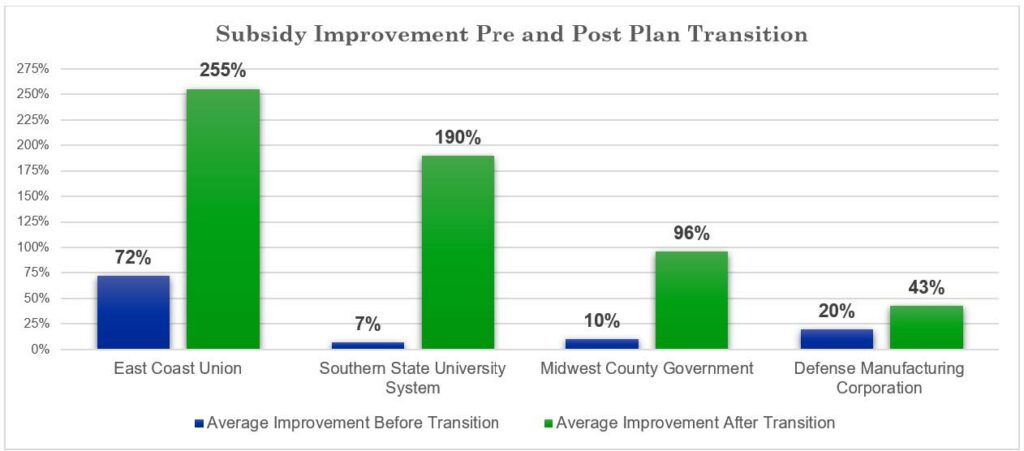RDS to EGWP Transition Overview
In Part D Advisors’ (PDA) years of experience with the Retiree Drug Subsidy (RDS) program and reopening appeals process, we have identified two-time frames where we find the greatest improvement in a plan sponsor’s subsidy; the years when they first begin the program and the years they are exiting.
The reason the early years show significant room for improvement are pretty obvious – the plan sponsor is new to the program and out of an abundance of caution or misunderstanding, leave money on the table they are eligible to collect. However, on the opposite side of the spectrum, plan sponsors exiting the RDS program (generally by transitioning all or some of their RDS eligible retirees to an MA-PD or EGWP plan) leave money behind for a variety of reasons, most of which can be attributed to staff and resource constraints.
Once a plan sponsor makes the decision to move all or some of their retiree population away from the RDS program they are now splitting their time administering at least two, sometimes more, separate health plans. Due to the nature of the program, a plan sponsor’s RDS obligations extend well beyond the end of their last RDS application plan year as Final Reconciliation is not completed until 15 months after the plan year ends.
Plan Changes are Opportunities
The best way for plan sponsors to recoup additional subsidy left behind during their transition out of the RDS program is by pursuing a reopening. For many plan sponsors, PDA’s reopening service has generated subsidy improvements of 50% or more during their transition years. The following table illustrates the dramatic increase PDA has found for reopening subsidy recoveries after a major plan change across multiple industries.

Click to enlarge.
Plan sponsors can significantly improve their subsidy collections by reopening plan years immediately preceding their transition out of the RDS program.
RDS-EGWP Transition Case Study
East Coast Union
The East Coast Union (ECU) shown in the Subsidy Improvement Pre and Post Plan Transition table above first hired Part D Advisors to reopen their previous RDS applications starting with plan year 2006 through 2019. Between 2006 and 2019, ECU underwent plan design changes that resulted in a significant drop in their RDS eligible plan’s membership count: 77% in 2012 and by an additional 31% in 2018. As shown in the two tables below, the subsidy improvement does not exceed 13% until a major plan change in 2012, where the reopening improvement jumps to over 160%. Between 2013 and 2018, subsidy improvement remains high but takes a drastic upturn during another plan change in 2019 where it skyrockets above 344%.

Click to enlarge.
When this East Coast Union made a plan change in 2012 and 2019 that drastically reduced their membership count, there was a steep, corresponding rise in their subsidy improvement during the reopening process.
Click to enlarge.
The dollar amount improvements associated with the reopening appeals post RDS to EGWP transition.
Plan Transition Considerations
- A plan sponsor’s RDS obligations don’t end immediately after a move into an EGWP or PDP plan. There are still at least two years of RDS obligations including: administrative steps, website user roles, eligibility updates, claims reporting, rebate calculations, and compliance tasks that must be completed.
- If plan sponsors do not properly meet lingering RDS obligations, they will be forced to pay back all the subsidy they have already been paid for those applications.
- Even if additional subsidy is not the primary goal of a reopening, plans will often need assistance (and can benefit from) correcting member demographic records and Medicare eligibility as they begin administration of their new plans.
- Most plan sponsors do not have access to their historical claims data making the six year RDS data retention and audit requirements difficult should a CMS audit occur.
The PDA Solution
When a plan sponsor makes the decision to move all or some of their retiree population away from the RDS program, PDA can help by taking over the lingering RDS obligations by completing any outstanding eligibility updates, reconciliations, and administrative tasks. Next, PDA can file reopening appeals, which can generate significant subsidy recoveries and correct issues with historical applications. The reopening process is entirely risk free – if the Fund does not receive additional subsidy, there is no cost. Finally, PDA provides six years of audit support and data warehousing for every application we complete, whether it’s for the plan’s remaining RDS years or a reopening appeal.
Click here for additional information about the reopening process during or after an EGWP transition or contact PDA for a risk-free, no obligation consultation today.

